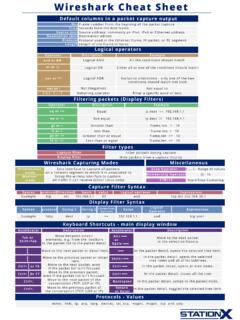Transcription of Certified Ethical Hacker (CEH) Exam Cheat Sheet
1 Single Authority: CA at top. Trust based on CA itselfHierarchical: CA at top. RA s Under to manage certsXMKS - XML PKI SystemCryptography AttacksKnown Plain-text: Search plaintext for re-peatable sequences. Compare to t versions. Ciphertext-only: Obtain several messages with same algorithm. Analyze to reveal repeating : Performed in MITM. Repeat exchange to fool system in setting up a comms CertificateUsed to verify user identity = nonrepudia-tionVersion: Identifies format. Common = V1 Serial: Uniquely identify the certificate Subject: Whoever/whatever being identi-fied by certAlgorithm ID: Algorithm usedIssuer: Entity that verifies authenticity of certificateValid from/to: Certificate good through datesKey usage: Shows for what purpose cert was made Subject s public key: self-explanatory Optional fields: , Issuer ID, Subject Alt information on targets, whereas foot-printing is mapping out at a high level. These are interchangeable in C|EH.
2 Google Hacking:Operator: keyword additional search items site: Search only within domainext: File Extensionloc: Maps Locationintitle: keywords in title tag of page allintitle: any keywords can be in title inurl: keywords anywhere in urlallinurl: any of the keywords can be in url incache: search Google cache onlyDNSport 53 nslokup (UDP), Zone xfer (TCP) DNS record typesService (SRV): hostname & port # of servers Start of Authority (SOA): Primary name serverPointer (PTR): IP to Hostname; for reverse DNSName Server (NS): NameServers with namespaceMail Exchange (MX): E-mail servers CNAME: Aliases in zone. list multi services in DNSA ddress (A): IP to Hostname; for DNS lookupDNS footprinting: whois, nslookup, digTCP Header Flags URG: Indicates data being sent out of band ACK: Ack to, and after SYNC ertified Ethical Hacker (CEH) Exam Cheat phases to a penetration testReconnaissanceScanning & EnumerationGaining AccessMaintaining Access Covering TracksAttack Types OS: Attacks targeting default OS settingsApp level: Application code attacks Shrink Wrap: off-the-shelf scripts and codeMisconfiguration.
3 Not configured well Legal18 1029 & 1030 RFC 1918 - Private IP StandardRFC 3227 - Collecting and storing dataISO 27002 - InfoSec GuidelinesCAN-SPAM - email marketingSPY-Act - License EnforcementDMCA - Intellectual PropertySOX - Corporate Finance ProcessesGLBA - Personal Finance DataFERPA - Education RecordsFISMA - Gov Networks Security StdCVSS - Common Vuln Scoring SystemCVE - Common Vulns and ExposureRegional Registry Coverage MapCryptographySymmetric EncryptionKey pairs required =Symmetric AlgorithmsDES: 56bit key (8bit parity); fixed block3 DES: 168bit key; keys 3 AES: 128, 192, or 256; replaced DESIDEA: 128bit keyTwofish: Block cipher key size 256bitBlowfish: Rep. by AES; 64bit blockRC: incl. RC2 RC6. 2,040key, RC6 (128bit block)Asymmetric EncryptionPublic key = Encrypt, Private Key = DecryptAsymmetric AlgorithmsDiffie-Hellman: key Exchange, used in SSL/IPSecECC: Elliptical Curve. Low process power/MobileEI Gamal: !=Primes, log problem to encrypt/signRSA: 2 x Prime 4,096bit.
4 Modern AlgorithmsMD5: 128bit hash, expres as 32bit hexSHA1: 160bit hash,rq 4 use in US appsSHA2: 4 sep hash 224,256,384,512 Trust ModelsWeb of trust: Entities sign certs for each otherPSH: Forces delivery without concern for bufferingRST: Forces comms termination in both direc-tions SYN: Initial comms. Parameters and se-quence # sFIN: ordered close to communications DHCPC lient Discover-> ServerClient< Offers - ServerClient Request > ServerClient< -ACK - ServerIP is removed from poolScanning & EnumerationICMP Message Types0: Echo Reply: Answer to type 8 Echo Request 3: Destination Unreachable: No host/ network Codes0 Destination network unreachable1 Destination host unreachable6 Network unknown 7 Host unknown9 Network administratively prohibited10 Host administratively prohibited13 Communication administratively pro-habited4: Source Quench: Congestion control mes-sage5: Redirect: 2+ gateways for sender to use or the best route not the configured default gatewayCodes0 redirect datagram for the network 1 redirect datagram for the host 8: Echo Request: Ping message requesting echo11: Time Exceeded.
5 Packet too long be routed CIDRM ethod of the representing IP Addresses IPv4 Notation/30=4 /28=16 /26=64 /24=256 /22=1024 /20=4096 Port Numbers0 1023: Well-known1024 49151: Registered 49152 65535: DynamicImportant Port NumbersFTP: 20/21 SSH: 22 Telnet: 23 SMTP: 25 WINS: 42 TACACS: 49 DNS: 53 HTTP: 80 / 8080 Kerbers: 88 POP3: 110 Portmapper (Linux): 111 NNTP: 119 NTP: 123 RPC-DCOM: 135 NetBIOS/SMB: 137-139 IMAP: 143 SNMP: 161/162 LDAP: 389 HTTPS: 443 CIFS: 445 RADIUS: 1812 RDP: 3389 IRC: 6667 Printer: 515,631,9100 Tini: 7777 NetBus: 12345 Back Orifice: 27374 Sub7: 31337 HTTP Error Codes200 Series - OK400 Series - Could not provide req500 Series - Could not process reqNmapNmap is the de-facto tool for this pen-test phaseNmap <scan options> <target>-sA: ACK scan -sF: FIN scan-sS:SYN-sT: TCP scan-sI: IDLS scan -sn: PING sweep-sN: NULL-sS: Stealth Scan -sR: RPC scan -Po: No ping-sW: Window -sX: XMAS tree scan-PI: ICMP ping - PS: SYN ping-PT: TCP ping -oN: Normal output-oX: XML output -A OS/Vers/Script-T<0-4>: Slow - FastScan TypesTCP: 3 way handshake on all ports.
6 Open = SYN/ACK, Closed = RST/ACK SYN: SYN packets to ports (incomplete hand-shake).Open = SYN/ ACK, Closed = RST/ ACKFIN: Packet with FIN flag set Open = no response, Closed = RSTXMAS: Multiple flags set (fin, URG, and PSH) Binary Header: 00101001 Open = no response, Closed = RSTACK: Used for Linux/Unix systemsOpen = RST, Closed = no responseIDLE: Spoofed IP, SYN flag, designed for = SYN/ACK, Closed= RST/ACKNULL: No flags set. Responses vary by OS. NULL scans are designed for Linux/ Unix -a COMPUTER 190nbtstat -A remote tablenbtstat -n local name table nbtstat -c local name cachenbtstat -r -purge name cachenbtstat -S 10 -display ses stats every 10 sec 1B ==master browser for the subnet1C == domain controller1D == domain master browserSNMPUses a community string for PWSNMPv3 encrypts the community stringsSniffing and Evasion IPv4 and IPv6 IPv4 == unicast, multicast, and broadcast IPv6 == unicast, multicast, and anycast. IPv6 unicast and multicast scope includes link local, site local and AddressFirst half = 3 bytes (24bits) = Org UID Second half = unique numberNAT (Network Address Translation) Basic NAT is a one-to-one mapping where each internal IP== a unique public overload (PAT) == port address trans-lation.
7 Typically used as is the cheaper InspectionConcerned with the connections. Doesn t sniff ever packet, it just verifies if it s a known connection, then passes TunnellingCra fting of wrapped segments through a port rarely filtered by the Firewall ( , 80) to carry payloads that may otherwise be IDSIt has 3 modes:Sniffer/Packet logger/ Network IDS. Config file: /etc/snort, or c:\snort\etc #~alert tcp!HOME_NET any ->$HOME_ NET 31337 (msg : BACKDOOR AT-TEMPT-Back-orifice. )Any packet from any address !=home net-work. Using any source port, intended for an address in home network on port 31337, send port: port mirroringFalse Negative: IDS incorrectly reports stream cleanIDS Evasion TacticsSlow down OR flood the network (and sneak through in the mix) OR fragmentation TCPdump syntax#~tcpdump flag(s) interfaceAttacking a SystemC|EH rules for passwordsMust not contain user s name. Min 8 chars. 3 of 4 complexity components. , Special, Number, Uppercase, LowercaseLM Hashing7 spaces hashed: AAD3B435B51404EE Attack typesPassive Online: Sniffing wire, intercept cleartext password / replay / MITM Active Online: Password guessing.
8 Offline: Steal copy of password , SAM file. Cracking efforts on a separate system Non-electronic: Social Engineering SidejackingSteal cookies exchanged between systems and use tp perform a replay-style attack. Authentication TypesType 1: Something you knowType 2: Something you haveType 3: Something you areSession HijackingRefers to the active attempt to steal an entire established session from a target 1. Sniff traffic between client and server2. Monitor traffic and predict sequence3. Desynchronise session with client 4. Predict session token and take over session 5. Inject packets to the target serverKerberosKerberos makes use of symmetric and asym-metric encryption technologies and involves:KDC: Key Distribution CentreAS: Authentication ServiceTGS: Ticket Granting ServiceTGT: Ticket Granting TicketProcess1. Client asks KDC (who has AS and TGS) for ticket to authenticate throughout the net-work. this request is in clear Server responds with secret key.
9 Hashed by the password copy kept on AD server (TGT).3. TGT sent back to server requesting TGS if user Server responds with ticket, and client can log on and access network fileC:\Windows\system32\configRegistry2 elements make a registry setting: a key (location pointer), and valu (define the key setting).Rot level keys are as follows:HKEY_LOCAL_MACHINE_Info on Hard/soft-wareHKEY_CLASSES_ROOT Info on file associ-ations and Object Linking and Embedding (OLE) classesHKEY_CURRENT_USER Profile info on current userHKEY_USERS User config info for all active users HEKY_CURRENT-CONFIG pointer to\hard-ware Profiles\.HEKY_LOCAL-MACHINE\Software\Mi cro-soft\Windows\CurrentVersionSocial EngineeringHuman based attacksDumpster diving Impersonation Technical SupportShould SurfingTailgating/ PiggybackingComputer based attacksPhishing - Email SCAMW haling - Targeting CEO sPharming - Evil Twin Website\RunServicesOnce\RunServices\Run Once\RunTypes of Social EngineersInsider Associates: Limited Authorized AccessInsider Affiliates: Insiders by virtue of Affilia-tion that spoof the identity of the Insider Outsider Affiliates: Non-trusted outsider that use an access point that was left openPhysical Security3 major categories of Physical Security measuresPhysical measures: Things you taste, touch, smellTechnical measures: smart cards, biometrics Operational measures: policies and proce-duresWeb-based HackingCSRF - Cross Site Request ForgeryDot-dot-slash AttackVariant of Unicode or un-validated input attackSQL Injection attack typesUnion Query.
10 Use the UNION command to return the union of target Db with a crafted DbTautology: Term used to describe behavior of a Db when deciding if a statement is true. Blind SQL Injection: Trial and Error with no responses or based SQL Injection: Enumeration technique. Inject poorly constructed com-mands to have Db respond with table names and other informationBuffer OverflowA condition that occurs when more data is written to a buffer than it has space to store and results in data corruption. Caused by insufficient bounds checking, a bug, or poor configuration in the program : Premise is all program calls are kept in a stack and performed in to change a function pointer or variable to allow code exeHeap: Takes advantage of memory on top of the application (dynamically allocated). Use program to overwrite function pointers NOP Sled: Takes advantage of instruction called no-op . Sends a large # of NOP in-structions into buffer. Most IDS protect from this SQL functions The following do not check size of destination buffers:gets() strcpy() stract() printf()Wireless Network HackingWireless sniffingCompatible wireless adapter with promiscu-ous mode is required, but otherwise pretty much the same as sniffing SpecificationsWEP: RC4 with 24bit vector.




